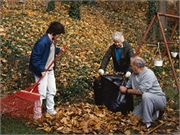- CDC Cuts Key Smoking Programs Despite Success in Curbing Smoking Rates
- RFK Jr. Touts Vaccine While At Funeral of Texas Girl Who Died of Measles
- Biden Plan To Expand Obesity Drug Coverage Is Rejected
- Most Eligible Smokers Not Getting Lung Cancer Screening
- Heart-Related Deaths More Likely During Day/Night Heatwaves
- Wildfire Smoke Increases Risk Of Mental Health Problems
- Some Folks Hit With Fees for Using Health Care Message Portals
- Diarrhea-Causing Bacteria Spreading Undetected Through Hospitals
- Ozone Pollution Increases Risk Of Childhood Asthma
- Knee Replacement Recovery Time: What You Need To Know
Raking Your Leaves to the Edge of Your Yard an Invitation to Ticks

Where you put leaves raked from your yard last fall could affect your family’s risk of bites from ticks that transmit Lyme disease-causing bacteria, a new study suggests.
In areas where Lyme-causing ticks are prevalent, homes are often near forested areas, and ticks thrive in these habitats between lawn and woods.
Raking or blowing leaves from your lawn just out to the forest edge could pose a risk by creating an ideal habitat for blacklegged (deer) ticks, according to the study published March 18 in the Journal of Medical Entomology.
“Our study showed that the common fall practice of blowing or raking leaves removed from lawns and landscaping to the immediate lawn/woodland edges can result in a three-fold increase in blacklegged tick numbers in these areas the following spring,” said study co-author Robert Jordan. He’s a research scientist in the Monmouth County Division of Mosquito Control in New Jersey.
For the study, his team created test plots on three residential properties in the fall of 2017 and 2018.
“The thing homeowners need to keep in mind is that accumulations of leaves and other plant debris provide ideal host-seeking and survival conditions for immature black-legged ticks,” Jordan said in a journal news release.
Researchers said homeowners should use curbside leaf pickup (if available); compost their leaves; or put leaves deeper into the woods or farther from high-use areas of their property.
“On properties with considerable leaf fall, the best option would be complete removal of leaves from areas most frequently used — such as lawns, outdoor seating areas, and in and around play sets,” Jordan said.
“If this is not possible or practical, leaf piles should be placed in areas least frequently used. Where neither of these options is possible, or where leaf fall is minimal, mulching in place may be a good option, since this encourages rapid decomposition of leaves, which may reduce habitat suitability for ticks,” he added.
More information
The U.S. Centers for Disease Control and Prevention has more on ticks.
Source: HealthDay
Copyright © 2025 HealthDay. All rights reserved.










